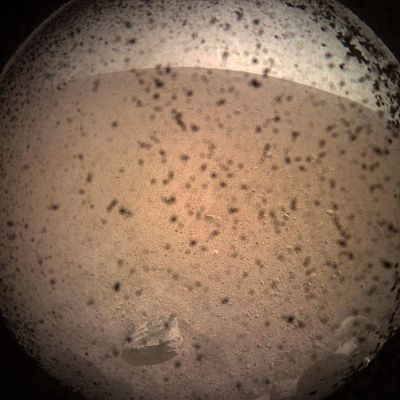The successful touch-down marks the beginning of the next phase of the two-year, $850-million mission.
When NASA's InSight lander successfully touched down on Mars yesterday, it was the end of a seven-month journey to the Red Planet. But the landing also marked the beginning of the next phase of the spacecraft's two-year, $850-million mission.
"Now that we're on the surface of Mars, we have a lot of work to go," Elizabeth Barrett, who leads the team at NASA's Jet Propulsion Laboratory charged with deploying and operating InSight's instruments, said in a news briefing yesterday after the landing.
"The first thing we'll do is assess the health of our spacecraft and the health of the instruments that went with us, and then look at our landing site," she added.
The 800-pound lander is parked on a broad plain north of the Martian equator known as Elysium Planitia — a mostly rock-free area that was faintly visible in the first photo sent back from the lander. Over the next two to three months, Barrett and her team will direct the lander's six-foot-long robotic arm to pluck each science instrument from the craft and place it directly on the Martian surface.
"I liken it to playing that claw game at a carnival, but you're doing it with a really, really valuable prize, and you're doing it blindfolded, where you can only take occasional pictures, and then you're doing it via remote control on another planet," Barrett said.
The team will begin with InSight's dome-shaped seismometer, which is designed to eavesdrop on Mars' deep interior, listening in on seismic activity and measuring the frequency and magnitude of marsquakes.
Space
About two weeks after the seismometer and its protective shield are in place, the arm will be used to deploy a probe that will hammer itself as far down as 16 feet below the surface. This probe will measure how much heat is coming from deep within the planet.
The seismometer and heat probe are designed to give scientists new insights into how Mars, Earth and other rocky planets formed and evolved.
Even though InSight's landing spot is mostly flat, placing the craft's instruments on the surface is a delicate, risky process. But the team at the Jet Propulsion Lab in Pasadena, California, will have time to rehearse.
"We have a test bed here that we'll actually terraform to look very much like the Martian area we land in, and we'll practice deploying to make sure everything is going to go smoothly," Barrett said.
Once InSight's instruments are in place, the lander's science mission can begin in earnest. "At that point, we'll be sitting back and listening for those marsquakes and measuring the vital signs of Mars," Barrett said. "We're really looking forward to that."












